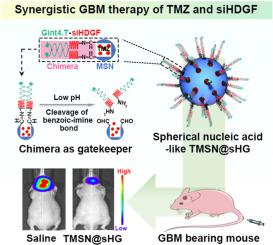当前位置:
X-MOL 学术
›
Biomaterials
›
论文详情
Our official English website, www.x-mol.net, welcomes your
feedback! (Note: you will need to create a separate account there.)
Gint4.T-siHDGF chimera-capped mesoporous silica nanoparticles encapsulating temozolomide for synergistic glioblastoma therapy
Biomaterials ( IF 12.8 ) Pub Date : 2024-01-20 , DOI: 10.1016/j.biomaterials.2024.122479 Huaijun Fei 1 , Yang Jin 1 , Nan Jiang 1 , Yuhan Zhou 1 , Ningcheng Wei 1 , Yifan Liu 1 , Jiayi Miao 1 , Liying Zhang 1 , Rui Li 1 , Aixia Zhang 1 , Shuhu Du 2
Biomaterials ( IF 12.8 ) Pub Date : 2024-01-20 , DOI: 10.1016/j.biomaterials.2024.122479 Huaijun Fei 1 , Yang Jin 1 , Nan Jiang 1 , Yuhan Zhou 1 , Ningcheng Wei 1 , Yifan Liu 1 , Jiayi Miao 1 , Liying Zhang 1 , Rui Li 1 , Aixia Zhang 1 , Shuhu Du 2
Affiliation

|
Due to glioblastoma (GBM) being the most intractable brain tumor, the continuous improvement of effective treatment methods is indispensable. The combination of siRNA-based gene therapy and chemotherapy for GBM treatment has now manifested great promise. Herein, Gint4.T-siHDGF chimera-capped mesoporous silica nanoparticles (MSN) encapsulating chemotherapy drug temozolomide (TMZ), termed as TMSN@siHDGF-Gint4.T , is developed to co-deliver gene-drug siHDGF and TMZ for synergistic GBM therapy. TMSN@siHDGF-Gint4.T possesses spherical nucleic acid-like architecture that can improve the enzyme resistance of siHDGF and increase the blood-brain barrier (BBB) permeability of the nanovehicle. The aptamer Gint4.T of chimera endows the nanovehicle with GBM cell-specific binding ability. When administered systemically, TMSN@siHDGF-Gint4.T can traverse BBB and enter GBM cells. In the acidic lysosome environment, the cleavage of benzoic-imine bond on MSN surface leads to an initial rapid release of chimera, followed by a slow release of TMZ encapsulated in MSN. The sequential release of siHDGF and TMZ first allows siHDGF to exert its gene-silencing effect, and the downregulation of HDGF expression further enhances the cytotoxicity of TMZ. In vivo experimental results have demonstrated that TMSN@siHDGF-Gint4.T significantly inhibits tumor growth and extends the survival time of GBM-bearing mice. Thus, the as-developed TMSN@siHDGF-Gint4.T affords a potential approach for the combination treatment of GBM.
中文翻译:

Gint4.T-siHDGF 嵌合介孔二氧化硅纳米颗粒封装替莫唑胺用于协同胶质母细胞瘤治疗
由于胶质母细胞瘤(GBM)是最难治的脑肿瘤,有效治疗方法的不断改进必不可少。基于 siRNA 的基因疗法和化疗相结合治疗 GBM 现已显示出巨大的前景。在此,Gint4.T-siHDGF 嵌合介孔二氧化硅纳米颗粒(MSN)封装化疗药物替莫唑胺(TMZ),称为 TMSN@siHDGF-Gint4.T,被开发用于共同递送基因药物 siHDGF 和 TMZ 用于协同 GBM 治疗。 TMSN@siHDGF-Gint4.T 具有球形核酸样结构,可以提高 siHDGF 的酶抗性并增加纳米载体的血脑屏障(BBB)通透性。嵌合体的适配体Gint4.T赋予纳米载体具有GBM细胞特异性结合能力。当全身给药时,TMSN@siHDGF-Gint4.T 可以穿过 BBB 并进入 GBM 细胞。在酸性溶酶体环境中,MSN表面苯甲酸-亚胺键的断裂导致嵌合体最初快速释放,随后缓慢释放封装在MSN中的TMZ。 siHDGF和TMZ的顺序释放首先使siHDGF发挥其基因沉默作用,而HDGF表达的下调进一步增强了TMZ的细胞毒性。体内实验结果表明,TMSN@siHDGF-Gint4.T显着抑制肿瘤生长,延长GBM小鼠的生存时间。因此,所开发的TMSN@siHDGF-Gint4.T为GBM的联合治疗提供了一种潜在的方法。
更新日期:2024-01-20
中文翻译:

Gint4.T-siHDGF 嵌合介孔二氧化硅纳米颗粒封装替莫唑胺用于协同胶质母细胞瘤治疗
由于胶质母细胞瘤(GBM)是最难治的脑肿瘤,有效治疗方法的不断改进必不可少。基于 siRNA 的基因疗法和化疗相结合治疗 GBM 现已显示出巨大的前景。在此,Gint4.T-siHDGF 嵌合介孔二氧化硅纳米颗粒(MSN)封装化疗药物替莫唑胺(TMZ),称为 TMSN@siHDGF-Gint4.T,被开发用于共同递送基因药物 siHDGF 和 TMZ 用于协同 GBM 治疗。 TMSN@siHDGF-Gint4.T 具有球形核酸样结构,可以提高 siHDGF 的酶抗性并增加纳米载体的血脑屏障(BBB)通透性。嵌合体的适配体Gint4.T赋予纳米载体具有GBM细胞特异性结合能力。当全身给药时,TMSN@siHDGF-Gint4.T 可以穿过 BBB 并进入 GBM 细胞。在酸性溶酶体环境中,MSN表面苯甲酸-亚胺键的断裂导致嵌合体最初快速释放,随后缓慢释放封装在MSN中的TMZ。 siHDGF和TMZ的顺序释放首先使siHDGF发挥其基因沉默作用,而HDGF表达的下调进一步增强了TMZ的细胞毒性。体内实验结果表明,TMSN@siHDGF-Gint4.T显着抑制肿瘤生长,延长GBM小鼠的生存时间。因此,所开发的TMSN@siHDGF-Gint4.T为GBM的联合治疗提供了一种潜在的方法。











































 京公网安备 11010802027423号
京公网安备 11010802027423号